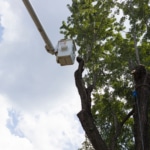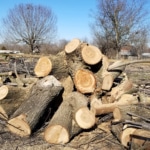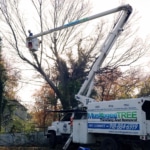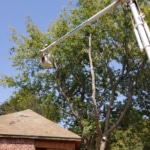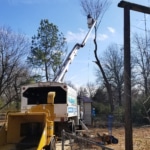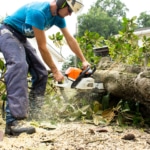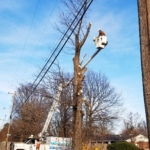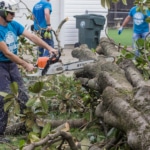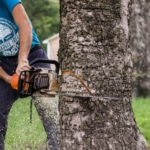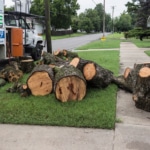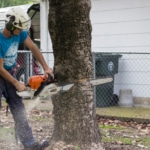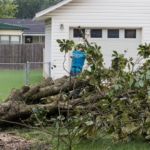Tree Removal
- Overview
- F.A.Q.
- Pricing
The process of Tree Removal can be as simple as making a few small cuts on the trunk and laying a tree down whole (also called “felling”), or - more commonly - as complicated as any number of days spent meticulously dismantling its canopy one branch at a time. One thing is sure; tree removal is a mentally taxing, physically challenging, and above all - an extremely hazardous occupation. In fact, according to recent data compiled from multiple sources, tree felling is the most dangerous job in America, claiming nearly eight lives per one thousand workers that year. If you have problem trees on your property and are looking for a permanent solution, please, think twice before attempting to remove them yourself. Hiring qualified professionals is a small price to pay when your life and livelihood are at stake.
At Muskogee Tree, we pride ourselves on a flawless record of safely executed removals, top-notch clean-up, and 5-star customer satisfaction. Years of combined knowledge and experience enables us to bring the correct tools, current standards, and unshakeable resolve to bear against whatever unique challenges your trees may pose. Tree removal is a complex and dangerous undertaking - you don't have to face it alone. Call Muskogee Tree today for a free site review and consultation.
- Will my yard or fences be damaged?
- I have a very large tree. How long will it take to remove it?
- How much does Tree Removal cost?
- Is stump grinding included?
- Can I keep some of the wood?
- Will I have any options to adjust the cost?
- Is there anything I should do to prepare for the job?
- What if there are electric lines running through / touching the tree?
Our number one priority is the preservation of your property, including any and all structures, fences, decorations, and lawn furniture. Sometimes there’s just no way around leaving a visible footprint behind (tire impressions, lawn impact damage, scattered sawdust, etc.) but we will do our absolute best to notify you of these possibilities ahead of time as we actively work to minimize these issues whenever possible. Most of the time any remaining signs that our crew was even on your property will diminish greatly or completely in just a few weeks.
It’s difficult to give an estimate of completion time without seeing the tree in person, but large mature trees (usually 50′ in height and up) typically take between 2 to as many as 5 or 6 days to remove, depending on the tree’s location, fullness of canopy, and nearby hazards or structures.
On average, we find that the majority of Tree Removals we perform cost between $400 and $1,000, but can cost as high as $5,000 - $10,000 in extreme circumstances. The cost for Tree Removal can fluctuate dramatically between different jobs, and there are a few key variables that we take into consideration when formulating your quote. For more information on these factors see the “Pricing” tab above. We always base your quote on the circumstances of the individual job as they relate to the specific items detailed in the "Pricing" tab.
Stump Grinding is not included in the base price for Tree Removal. Our general practice is to cut all removal stumps as low as we can get them and applying an over-the-counter herbicide at no additional cost that will kill the stump in most cases. However, we do offer Stump Grinding as an additional service and are happy to include this as a line-item on your quote at your request.
Absolutely! In fact it will probably save you some money if you decide to keep some or all of the wood.
Yes. Typically we include the cost of removal/dismantling and disposal of the debris in one line-item for simplicity, but at your request, we can itemize every aspect of the removal itself, from breaking down the disposal costs all the way to labor and clean-up of small debris. If you want several options for minimizing your Cost Of Service just let us know before we generate your physical quote!
There is! We have an article that details the most important things you can do to prepare your property, self, and any guests for Tree Removal.
Safety is of the utmost concern on all of our job sites. Because of this, when we look at a job where utility service lines (especially electrical lines of any kind) are within close proximity to the tree or work area we have to proceed from a position of caution. These jobs pose more challenges and therefore take more time and labor to complete safely, and your Cost Of Service will generally reflect this. However, there are a few things that we can do to minimize and in some instances, eliminate these obstacles completely. For your home electrical service, we can usually request a Temporary Disconnect. For other cable-based services such as phone and Telecom, typically we can temporarily disconnect or lower the lines while work is being done. All lines disconnected by Muskogee Tree will be put back in place to the best of our ability when the work is complete. Your electrical service provider will be the ones disconnecting and reconnecting your Electric.
There are multiple variables taken into account that help us estimate how long any given job will take, which is the primary factor in determining your Cost Of Service. Below are the most important variables that we use to formulate your quote for Tree Removal.
- Size And Species
- Location And Proximity Hazards
- Tree Health And General Disposition
- Methods Of Access
- Methods Of Work
- Extrication Obstacles And Hazards
- Disposal And Clean-Up Options
- Additional Equipment Or Subcontracted Services
Obviously, a Tree's Size is an important factor in determining how long it will take to remove, but we also have to take into account the Species of that Tree. Each Species has it's own particular growth patterns, density properties, and biological hazards such as hard thorns or allergens that can determine how quickly the climber/bucket operator can move in the tree, set rigging points, and if any special protective equipment will be needed.
The location of your Removal is probably the most important factor in pricing. If the tree is in a field with nothing surrounding it but grass, even if it's a particularly difficult species or very large, the time it takes to remove it will be much less than if that same tree is in your backyard and hanging over your house. Because we are extremely careful when working around your personal property and home, Trees that are close to your house will take longer, as will trees that are near power lines/utilities, or that grow entangled with other trees.
A Tree's health has a significant impact on the time it takes to safely remove it. If the tree requires extensive rigging operations to dismantle due to proximity hazards, we have to be certain that there are sufficient rigging points and that those points are structurally sound. If the tree is infested with parasitic organisms like Mistletoe, vines, or certain insects it's a dead giveaway that there will be decay and cavitations inside the tree that may not be visible upon inspection as well as direct delays caused by the organisms themselves. For this reason, if a Tree is in particularly poor health or shows signs of heavy stress we have to consider that the Tree will take a little longer to safely remove.
There are 3 primary methods that we use to access Trees for removal: Bucket Truck Access, Climbing Access, and Ground Access. Each of these methods has their own strengths and weaknesses, but most often we are forced to choose the Method Of Access based on the criteria already mentioned above. For instance, "Ground-Based Access" is fast and easy but we can't very well just notch and drop a 60 foot Oak tree sitting 10 feet from your house. At the same time, a small 15-foot Redbud Tree sitting near the road should rarely require us to physically enter the tree for removal.
The Method Of Work refers to how the tree is actually brought to the ground. In most cases, Trees have to be dismantled in relatively small pieces which take more time, especially considering the size of the Tree. In some cases, the Tree can be notched and laid over in just a few minutes, and the dismantling process (for disposal) can take place on the ground. This process is obviously much quicker and safer, but it's rarely an option.
If the Tree is to be dismantled while it's still standing, we have to take into account extrication obstacles and drop-zone hazards that may slow down the process of physically moving the cut debris from the tree to the ground, and from the ground to the disposal area (in cases where disposal is included). In some instances, the debris can simply be "cut and dropped" or "cut and tossed" directly from the canopy. However, in cases where there are structures, utility lines, limbs from other trees, or other immovable hazards in the drop-zone we may have to use additional rigging operations that can considerably lengthen the amount of time it takes to safely complete the removal. If the debris itself is difficult to extricate from the drop zone due to things like fences, narrow gates or car-ports, or yard furniture/decorations, etc., this can also increase the time it takes to complete the job.
Unless requested otherwise, we quote all Removal jobs to include full disposal and clean-up of cut debris. In the cases of larger trees, especially heavy Species like Oak and Pecan, disposal takes much more time, fuel, and physical labor. In the summer and autumn months, leaves add additional time to job site clean-up. These services are optional and can be itemized for inclusion/exclusion at your request.
Occasionally, on very large Trees, hard to access Trees, or Trees that are in particularly poor health additional equipment or subcontracted services such as a Crane and Operator, Roll-off Dumpsters & Service, etc. may be required. In these instances, we will discuss all requirements with you prior to formulating our Quote.


